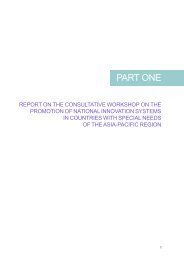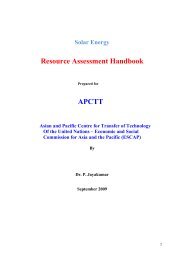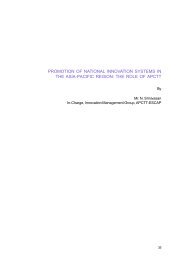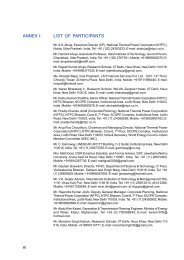Download Complete PDF - apctt
Download Complete PDF - apctt
Download Complete PDF - apctt
- No tags were found...
You also want an ePaper? Increase the reach of your titles
YUMPU automatically turns print PDFs into web optimized ePapers that Google loves.
emissions. Underground coal gasification (UCG) is another feasible method of coaluse and allows access to more global coal resources. Fluidized bed combustion (FBC)is a very flexible method of electricity production and improves the environmental impactof coal-based electricity – most combustible material can be burnt including coal,biomass and general waste. Renovation and modernization (R&M) for life extension ofold power plants is a cost-effective approach, as compared with adding greenfieldplant capacities. Growing environmental regulations would force many utilities withinthe country to go for revamping old polluting power plants using environmentally benigncirculation fluidized bed combustion (CFBC) technology.Supercritical technologies (SCT): India has embarked on a major plan to introduceSCT in view of reduced fuel costs, low emissions and good part load efficiency, thoughcostlier by 3-10 per cent over current plants. Market penetration of SCT systems isexpected to rise from the current 10 per cent to 50 per cent of new plants by 2020.Nine SCT coal pulverization units of 660 MW, in addition to seven ultra-mega powerplants using SCT, are in different stages of construction in India. R&D thrust areas inSCT includes materials and metallurgy for boiler and turbine components subjected tohigh temperatures and pressures, supercritical cycle optimization, incremental heatrate improvement, retrofit of supercritical boiler to sub-critical pulverized coal boiler,fluidized bed supercritical steam cycles and multi-reheat supercritical boilers withdouble/triple re-heater.Research & development: R&D and deployment should form the core activity in theFFT sector in India to meet both higher power capacity and lower emission targets.The National Energy Fund (NEF) and National Clean Energy Fund (NCEF) planned byGoI must be structured to fund energy research effectively.Technology development: Mechanisms that enable joint technology developmentamong public and private sector entities, under suitable norms for financing and sharingof intellectual property rights (IPR), would be essential. For technologies that are alreadymature and deployed in the developed countries, appropriate financing models areimportant and may become operational through multilateral institutions, carbon marketsand mechanisms like Clean Development Mechanism (CDM).Human resource for sustainable energy: Capacity building and human resourcedevelopment (HRD) for the energy sector is central for the execution of new plans. Atpresent, national expertise in different sectors is inadequate for this.Potential for international cooperation: There is considerable scope for internationalcooperation in sustainable energy specific to advanced FFT.Prof. Murthy’s presentation is provided as Annex III.Mr. T. Jayakumar, Director, Metallurgy and Materials Group, Professor & Dean, HomiBhabha National Institute, Indira Gandhi Centre for Atomic Research (IGCAR), made apresentation on “Advanced Ultra-Supercritical Power Plants – Development of Materialsand Manufacturing Technologies”.A power plant operating at steam pressures exceeding 225 kg/cm 2 is called“supercritical” plant. When such a supercritical plant functions with a main steamtemperature of ≥600°C, it is called “ultra-supercritical” (USC) plant. Table 1-1 provides8







